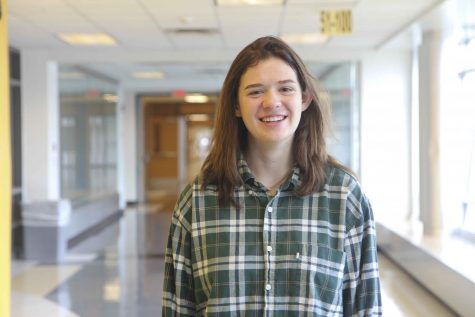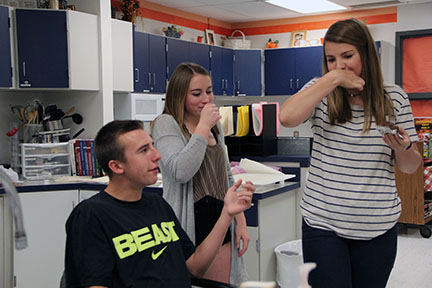The Facts on FACS
Teacher, students shed light on unnoted classes in FACS department
The classes containing the most essential pieces of knowledge for survival past high school often seem to also be the most ignored.
Family and Consumer Science classes, or FACS classes, encompass the art of sewing, cooking, career-finding, relationship-building and family-making. For these subjects, Blue Valley has 11 classes dedicated to these subjects, all taught by one teacher — Kendra Smith.
“The most challenging part about teaching all these classes is switching from one subject to another because they’re not really all that related and so I can be teaching a foods class one hour, a child development class the next, and [then go teach] Interior design.,” Smith said. “It’s challenging trying to make sure I have all my ducks in a row for each different class.”
Despite her hectic schedule in result, Smith said she enjoys every class.
“The easiest part about all these classes is they’re fun classes to teach so that makes it easy,” Smith said. “I like teaching them.”
Mary Hastert — Food Decisions and Culinary Arts I
Imagine not having homemade meals prepared for you anymore.
Imagine eating Ramen noodles three meals a day, every day.
Imagine having to order take out every day because you don’t how cook anything else.
Every single day.
Family and Consumer Science teacher Kendra Smith said many students take her cooking classes to try and avoid situations like these in their college years by learning how to make healthy foods for themselves to prepare for when they are alone after high school.
“Food Decisions, a nutrition based class, will help for learning about what kinds of foods are healthy for you,” she said. “By taking this class, you can learn how to make some basic stuff for when you are away.”
For that reason, senior Mary Hastert said she is taking two foods classes this semester, Food Decisions and Culinary Arts I. She said the class is already benefitting her.
“I can now do basic every-day cooking and small stuff that other people don’t know, like using different utensils,” Hastert said.
Culinary Arts I counts as an art credit course for those taking the class.
“If you’re not into drawing and stuff like that, you can take my classes and get your art credit.” Smith said.
Essentially, Hastert said both classes are set up the same way.
“We take notes over a unit and then we cook what we learned in that unit,” Hastert said.
Despite similarities, she said she favors Culinary Arts I over Food Decisions because of its uniqueness.
“We do a lot more cooking and it’s a lot more advanced [in Culinary Arts I],” Hastert said. “My favorite food to cook was the stir fry — that was really fun.”
A unit enjoyed by many students in Food Decisions is targeted at the diets of students involved in sports, Smith said.
“[The class] includes a unit about the student athlete,” she said. “It outlines the things that you should and shouldn’t eat as an athlete.”
Hastert said the big project in Culinary Arts everybody enjoys is the cake decorating.
“I’m most proud of the cake that I made at the end,” Hastert said. “We had to decorate [the] whole cake.”
Smith said baking is very limited in the food courses offered to the students.
“I would like to see baking in future classes,” Smith said. “I would love to see a baking course in the foods area and I think a lot of students would take it.”
Kelly Zhang — Apparel and Interior Essentials
Working on portfolios.
Doing hands-on activities.
Collections filled with neatly arranged collages of room and fashion designs.
All of these elements are applied to Apparel & Interior Essentials — the prerequisite course for all advanced fashion and interior classes.
The class incorporates elements of fashion, sewing and room design.
Family and Consumer Science teacher Kendra Smith said she wished more people knew about the fashion side of this class.
“BV dropped fashion classes from the schedule and so fashion kind of made its way into the Apparel and Interior Essentials class,” Smith said. “Students don’t realize that’s what [the class] is supposed to be. Students don’t take it because they are looking for fashion but they can’t find it in the schedule.”
“I’m taking it for the fashion,” freshman Kelly Zhang said. “I’m thinking about a career in fashion marketing.”
Zhang said she enjoys the class because it’s a time to see her friends and learn about the principles of design.
“Up until now we’ve been doing portfolios and basically learn the elements and principles of interior design,” Zhang said. “It will help me in the future when I actually do fashion stuff and take more in-depth classes.”
For her sewing project, Zhang said she sewed a pillow case.
“It was the first time I actually used a sewing machine by myself, and I really enjoyed the creative freedom,” Zhang said. “It’s a white pillow case with a blue and floral-patterned trim.”
With the pillow case being the only sewing project assigned, Smith said she is disappointed in the lack sewing involved in the class’ curriculum.
“My passion is in sewing,” Smith said. “Unfortunately we don’t teach sewing much anymore in the high school. I wish we could put more sewing back into the classes, especially the fashion classes.”
Besides fashion, the class also tackles the element of interior design.
“The interior part of the class is fun too, but it’s not what I’m thinking about,” Zhang said.
Interior design covers a wide-variety of design in real-life situations, most specifically in the arrangement and layout of a room, Smith said.
“The interior design is fun because it’s based on how you decorate your house,” Smith said. “A lot of girls like to take that class because they’re changing their bedrooms all the time and this gives them different ideas.”
Smith said she applied what she teaches to her life many times.
“I love hand-drawing rooms out and placing furniture,” Smith said. “Every time I’ve moved I did that and then the movers would come in and they’d see the sign up on the door exactly laid out how I wanted it. I didn’t have to move the furniture after I moved into my house, it was already where I wanted it. It’s just something I like being able to do.”
Elizabeth Schrader — Child Development I
Crying babies.
Parenting advice.
Talks about future plans as well as controversial issues.
All of these subjects are encompassed in Child Development I and II.
Sophomore Elizabeth Schrader is one of the few sophomores who decided to take Child Development I this year.
“I took this class because I just wanted to take the baby home because I thought it would be fun, but it actually wasn’t,” Schrader said.
Though she may have not enjoyed taking the baby home, Schrader said she still how the class showed her what taking care of children is like.
Schrader said she learned many new things about parenting that she may not have expected.
“The interesting thing was learning about the different types of parenting and information about teen parenting and prevention,” she said.
Family and Consumer Science teacher Kendra Smith said her favorite class to teach is Child Development II.
“I like Child Development I and II, but Child Development II is more favored because it’s basically a person’s life from teenage years all the way through death,” she said. “We show a lot of videos like Mean Girls, and Licensed to Wed. It’s basically stages that you go through as you go through life, and it kind of helps prepare you for the things that may come up in life.”
Schrader said she can apply a lot of what she learned to everyday life.
“I definitely think that you can apply what we learned in that class in everyday life because it’s really important information you can use in the future, whether you want to be a parent or you want to find reasons not to be one,” she said. “It also gives you information about prevention.”
She said her favorite part about the class was being around the people in it.
“I thought it was a fun and easy class with fun people in it,” Schrader said. “It was fun to just discuss different things freely with them. It was like a place you could talk about things with your classmates.”
Though she enjoyed many aspects of the class, Schrader also found some things challenging in the curriculum.
“I think the most challenging part of this class was the homework load we sometimes had,” she said. “We had a lot of worksheets and projects we had to do.”
Smith said she thinks everyone should take these classes if they have room in their schedules.
“Personally, I think Child Development I and II should be taken by every student because it’s so important to the family,” she said. “I think that’s part of our problem in this society right now. The family is so broken apart and disjointed, and I think more students need to take it so they can maybe build a better family unit for the future.”
Smith said she would love to see more enrollment from the opposite gender in future classes.
“It’d be great if we had more guys in Child Development I because they’re going to be a dad at some point,” she said. “More than likely, 80 percent of the men in the school population will be a dad at some point and it would be nice if they knew how to take care of their future son or daughter.”
Overall, Schrader said she really enjoyed the course and is proud of the progress she made.
“I am most proud of surviving with the baby for a whole weekend because it was really hard,” Schrader said. “My mom didn’t want me to stay at home, so she made me take it out in public three times and it wouldn’t stop crying. Everybody was staring at me, but I got through it.”
Schrader said she is happy she took the class and enjoyed her time in Child Development I.
“My favorite memory of the class was just getting to know the people in it better and just discussing random things with my class,” she said.

Ifrah Sayyada is a staff writer for “The Tiger Print.” She enjoys writing features, opinions and news stories about current issues. Along with being...

Alli Williams is a co-editor in chief for “The Tiger Print.” She works as an assistant teacher at a math tutoring business. Her favorite part of journalism...




